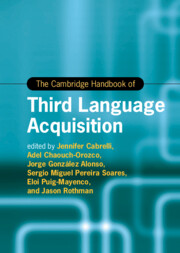Book contents
- The Cambridge Handbook of Third Language Acquisition
- Cambridge Handbooks in Language and Linguistics
- The Cambridge Handbook of Third Language Acquisition
- Copyright page
- Contents
- Figures
- Tables
- Contributors
- Introduction Multilingualism
- Part I Theoretical Approaches to L3/Ln
- Part II L3/Ln across Linguistic Domains
- Part III Becoming and Staying Multilingual at Different Ages
- 11 3L1 Acquisition
- 12 Multilingualism and Education
- 13 Language Attrition and L3/Ln
- 14 Heritage Speakers as L3 Acquirers
- 15 The Effects of Environment Change on Third Languages
- Part IV L3/Ln in Action
- Part V L3/Ln and Cognition
- Part VI Research Methods in L3/Ln
- Index
- References
14 - Heritage Speakers as L3 Acquirers
from Part III - Becoming and Staying Multilingual at Different Ages
Published online by Cambridge University Press: 13 July 2023
- The Cambridge Handbook of Third Language Acquisition
- Cambridge Handbooks in Language and Linguistics
- The Cambridge Handbook of Third Language Acquisition
- Copyright page
- Contents
- Figures
- Tables
- Contributors
- Introduction Multilingualism
- Part I Theoretical Approaches to L3/Ln
- Part II L3/Ln across Linguistic Domains
- Part III Becoming and Staying Multilingual at Different Ages
- 11 3L1 Acquisition
- 12 Multilingualism and Education
- 13 Language Attrition and L3/Ln
- 14 Heritage Speakers as L3 Acquirers
- 15 The Effects of Environment Change on Third Languages
- Part IV L3/Ln in Action
- Part V L3/Ln and Cognition
- Part VI Research Methods in L3/Ln
- Index
- References
Summary
This chapter examines a population of third language (L3) learners that has received little attention, namely heritage speaker (HS) L3 learners, who grow up speaking two languages in early childhood. Unlike traditionally studied L3 learners, who acquired their L2 as older children, HSs have two naturalistically acquired languages to draw from, which has been suggested to have implications for L3 acquisition. By examining existing linguistically oriented research with HS L3ers, we discuss (1) whether patterns of acquisition differ in HS L3ers as compared to traditionally studied populations, and (2) whether this differs for L3 morphosyntax versus L3 phonetics-phonology. After a brief discussion of methodological limitations, we conclude that transfer patterns in early bilinguals in many respects mirror those for late bilinguals. However, differences across the domains of L3 morphosyntax versus L3 phonology are evident, with phonetic–phonological transfer more likely to stem from the dominant language. Some explanations and suggestions for further research are offered.
- Type
- Chapter
- Information
- The Cambridge Handbook of Third Language Acquisition , pp. 354 - 379Publisher: Cambridge University PressPrint publication year: 2023
References
- 1
- Cited by



